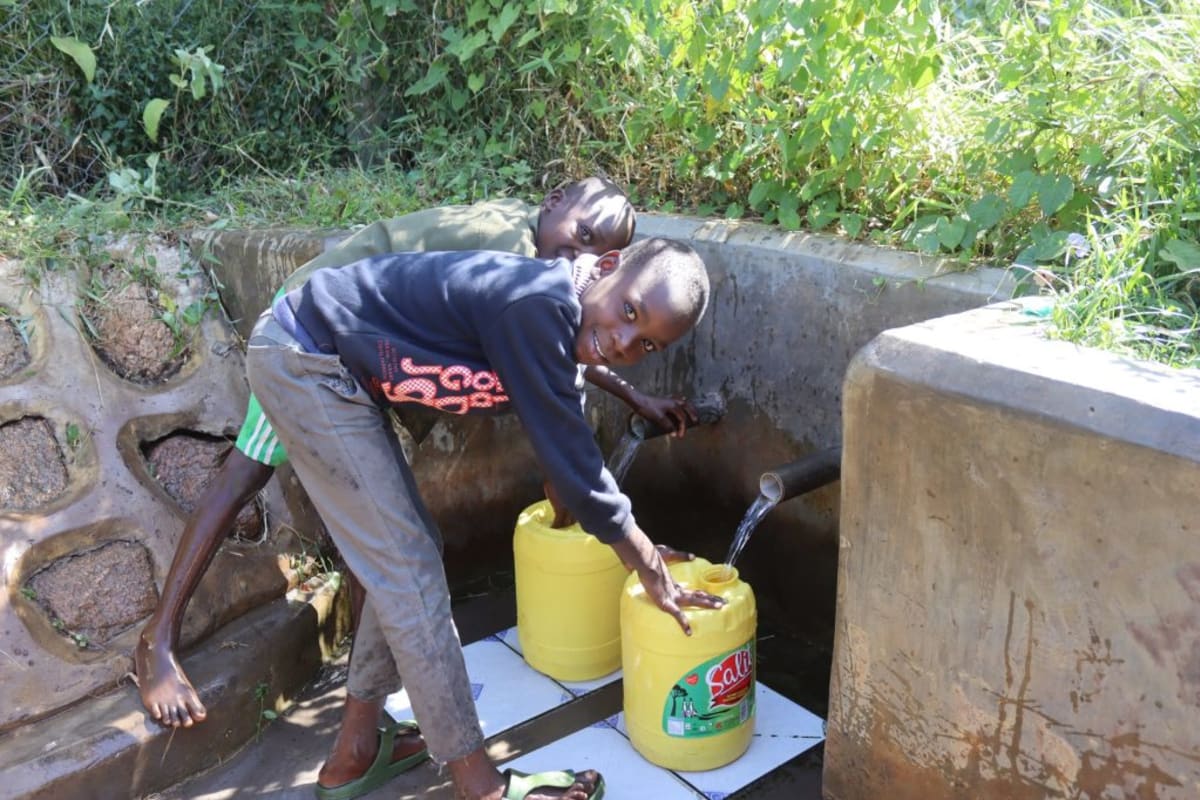"I have young grandchildren aged below 5-years-old who have had several episodes of diarrhea, which I suspect is because of the water source. The source lacks a chlorine dispenser. Thus it is the key suspected point of infection," said Mary Paulo, a farmer who lives in Mukhuyu.
Mary is 1 of 210 people in the community who depend on unprotected Anami Spring for water. As an open water source, the water is highly contaminated with dirt, algae, and farm chemicals, and animal waste that the rains carry in with the runoff. The water is not fit for human consumption, leading to frequent waterborne and water-related diseases throughout the community. The most commonly reported illnesses include Bilharzia, diarrhea, scabies, and dehydration. Community members lose a lot of time seeking medical attention and paying for medication to treat their water-related illnesses.
Fetching water from the spring is a messy and time-consuming process. Community members improvised a discharge pipe using a small corrugated metal held down in the water by a few small rocks. The water then flows over the metal and forms a small spout, where community members try to fit their jerrycans to fill them up. But the sheet metal is quite low to the ground, so the standard jerrycan cannot stand upright beneath it. This means at a certain point. Community members have to switch to using small jugs and cups to fill from the sheet to pour the water into their larger jerrycan. This process contributes to long lines and waits times at the spring, wasting women's and children's time that could be used for other work and responsibilities. As a result, women, in particular, fetch water at the spring from early morning to late evening, trying to meet their families' water needs.
"The water challenge makes me waste a lot of time while going for water, and I get to school late. This always makes me get punished," said Derrick, a primary school student in the community.
Because the spring is the only source of water for domestic and agricultural use, its unprotected states also impact food security. There is never enough water to irrigate gardens and water the animals, so people must consistently make choices that reduce their productivity and food security in one way or another.
Mukhuyu is in a rural set-up where there is no noise from vehicles, motorcycles, or even loud music. The roads are dusty now but become very slippery with mud during the rainy season. The people in this community are cosmopolitan in that various tribes live and work together in peace. Trees are planted everywhere, making the area beautiful and cool, especially in the dry season.
The most common livelihoods for the community members here are farming, livestock keeping, and running small businesses. Some people work casual labor day-jobs as well. The people in this community are welcoming and hospitable. During our most recent visit to write this report, every household offered our team food or drink. These gestures of kindness made them unique, the team noted.
What We Can Do:
Spring Protection
Protecting the spring will help provide access to cleaner and safer water and reduce the time people have to spend to fetch it. Construction will keep surface runoff and other contaminants out of the water. With the community’s high involvement in the process, there should be a good sense of responsibility and ownership for the new clean water source.
Fetching water is a task predominantly carried out by women and young girls. Therefore, protecting the spring and offering training and support will help empower the female members of the community by freeing up more of their time and energy to engage and invest in income-generating activities and their education.
Training on Health, Hygiene, COVID-19, and More
To hold training during the pandemic, we work closely with both community leaders and the local government to approve small groups to attend training. We ask community leaders to invite a select yet representative group of people to attend training which will then act as ambassadors to the rest of the community to share what they learn. We also communicate our expectations of physical distancing and wearing masks for all who choose to attend.
The training will focus on improved hygiene, health, and sanitation habits in this community. We will also have a dedicated session on COVID-19 symptoms, transmission routes, and prevention best practices.
With the community’s input, we will identify key leverage points to alter their practices at the personal, household, and community levels to affect change. This training will help ensure participants have the knowledge they need about healthy practices and their importance to make the most of their water points as soon as the water is flowing.
Our team of facilitators will use a variety of methods to train community members. Some of these methods include participatory hygiene and sanitation transformation, asset-based community development, group discussions, handouts, and demonstrations at the spring.
One of the most important issues we plan to cover is handling, storing, and treating water. Having a clean water source will be extremely helpful, but it is useless if water gets contaminated by the time it is consumed. The community and we strongly believe that all of these components will work together to improve living standards here, which will help to unlock the potential for these community members to live better, healthier lives.
We will then conduct a small series of follow-up training before transitioning to our regularly scheduled support visits throughout the year.
Training will result in the formation of a water user committee elected by their peers that will oversee the spring's operations and maintenance. The committee will enforce proper behavior around the spring and delegate tasks that will help preserve the site, such as building a fence and digging proper drainage channels. The fence will keep out destructive animals and unwanted waste, and the drainage will keep the area’s mosquito population at a minimum.

 Protected Spring
Protected Spring
 Rehabilitation Project
Rehabilitation Project





































